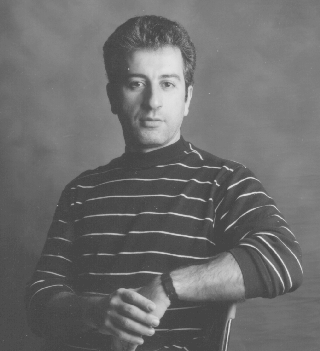NEW PAPER WATCH

Multiplex PCR Server: Genotyping, PCR Assays, Genome Walks, , "Rachlin, Ding, Cantor, Kasif
Recent Publications in Computational Biology
Selected Bioinformatics Publications
Delcher,
A., D. Harmon, S. Kasif, O. White and S. Salzberg, "Improved Microbial Gene
Identification with Glimmer", Nucleic Acids, Vol. 27, No. 23, pp. 4636--4641,
1999. Glimmer II.
Tettelin, H. D. Radune, S. Kasif, H. Khouri, and S. Salzberg, "Pipette Optimal Multiplexed PCR: Efficiently Closing Whole Genome Shotgun Sequencing Project", Genomics, Vol. 62, pp. 500--507, 1999.
S. Kasif, "Datascope: Mining Biological Sequences", IEEE
Intelligent Systems, pp. 38--46, 1999.
Beigel, R., N. Alon, S.M. Apaydin, L. Fortnow and S. Kasif, "An Optimal Multiplex PCR Protocol for Closing Gaps in Whole Genomes", Computational Genomics, Nov 2000.
B. Suzek, S. Kasif, B. Logan and P. Moreno, "Remote-Homology Detection Using Feature Vectors", in review.
S. Kasif, "Efficient Gene Discovery by Database Matching", by request.
Kasif, S., S. Banerjee, A. Delcher and G. Sullivan, "Some Results on the Complexity of Symmetric Connectionist Networks", Annals of Mathematics and Artificial Intelligence, 327-344, Nov. 1993.
Murthy, S., S. Kasif and S. Salzberg, "A System for Induction of Oblique Decision Trees'', Journal of Artificial Intelligence Research, 2:1 (1994),1--33, a popular decision tree system.
![]()
NEW PAPER WATCH
![]()
ANNOTATED RECENT PAPERS
1*. Walker, M., V. Pavlovic, and S. Kasif "A Comparative genomic method for the identification of prokaryotic translation sites", Nucleic Acid Research, 2002.
An application of comparative product HMMs (a new methodology for comparative genomics) for bacterial start-site identification. This is an increasingly important problem because of the opportunity to use comparative analysis of up-stream sequences for binding site identification leading to understand regulation in bacteria.
2*. Zheng, Y., R. Roberts and S. Kasif, "Computational identification of operons in microbial genomes", Genome Research, 2002
Identification of complex operons in bacterial genomes. Applications include identification of polyketides for production of antibiotics.
3*. Zheng, Y., R. Roberts and S. Kasif, "Genomic functional annotation using co-evolution profiles of gene clusters, Genome Biology 2002.
Continued collaboration with Dr. Richard Roberts.4*. Simon Kasif+, Zhiping Weng+, Richard Beigel, Charles DeLisi, "A Computational Framework for Optimal Masking in the Synthesis of Oligonucleotide Microarrays", Nucleic Acid Research 2002 (+ - contributed equally).
10-20% improvement in number of rounds needed to synthesize a microarray.
5*. Noga Alon, Richard Beigel and Simon Kasif and Steven Rudich and Benny Sudakov, "Learning a Hidden Matching", Proc. of Foundations of Computer Science (FOCS 2002), a theoretical treatment of multiplex PCR to close gaps in shot gun sequencing of genomes, joint project with Princeton Institute for Advanced Studies. Previous version of this algorithm has been used at MIT Genome Center and The Institute for Genomic Research to close the gaps in several major pathogens and archea.
6. Joseph D. Szustakowski, Ulas Karaoz, Serafim Batzouglou, James Galagan, Tarjei Mikkelsen, Zhiping Weng, Joel H. Graber, S. Kasif, On the Organization of Ancient and Modern Genes in the Human Genome, in review. (joint project with MIT Genome Center).
7. B. Logan, P. Moreno, B, Suzek and S. Kasif, "Learning Remote-Homology Using Probabilistic Feature Vectors", in review.
A new approach for classification of proteins into structural families.
8*. Yang Su, T. M. Murali S. Kasif, "RankGene", to appear Bioinformatics.
A system to identify diagnostic genes in microarray data.
9*. T. M. Murali and S. Kasif, "Discovering Conserved Gene Expression Motifs in Microarray Data", PSB 2002.
Identifying groups of genes whose expression profile is relatively conserved across a collection of conditions.
10*. J. Zhang, V. Pavlovic, C. Cantor, S. Kasif, "Cross Species Gene Identification in Human and Mouse Sequences using Evidence Integration Frameworks", in press Genome Research
joint project with Charles Cantor, Sequenom.
A new approach for gene prediction using multiple related genomes. The first evolutionary analysis of error based on evolutionary distance between organisms.
11. Y. Zheng, R. Roberts, S. Kasif, "Identification of the Adaptivity Layer of Microbial Organisms using Whole-Genome Variability Profiless", to be submitted, continued comparative genomics research with Rich Roberts on the structure of microbial organisms.12*. N. O. Stitziel, J. Tseng, D. Pervouchine, D. Goddeau, S. Kasif, J. Liang, "Structural Location of Disease-Associated Single Nucleotide Polymorphisms", in press Journal of Molecular Biology.
A approach for classifying SNPs using a novel structural analysis tool and conservation analysis.
13*. J. Wu, Simon Kasif, and Charles DeLisi, "Identification of functional links between genes using phylogenetic profiles", in press Bioinformatics.
A rigorous methodology for assigning function based on phylogenetic profiles.
14*. D. Pervouchine, J. Graber and S. Kasif, "On the normalization of RNA equllibrium to sequence length", to appear NAR.
An efficient method for whole genome RNA analysis.
15. T. M. Murali and S. Kasif, "Discovering Conserved Gene Expression Motifs in Microarray Data", in review.
16. S. Letovsky, S. Kasif, "A Probabilistic Approach to Gene Function Assignment and Propagation in Protein Interaction Networks", in review.
A systematic approach for Functional Gene Annotation using Protein-Protein interaction graphs. 30-40% of genes in newly sequenced organisms have not been assigned function. This approach promises to be a breakthrough in functional annotation.
17. V. Pavlovic, J. Zhang, C. Cantor, S. Kasif, "The Effect of Evolution: on the Performance of Comparative Gene Finders" , in preparation.
20. M. Schaffer, J. Tullai, S. Kasif and G. Cooper, Cold Spring Harbor Meeting on System Biology.
21. Noga Alon, Richard Beigel and Simon Kasif and Steven Rudich and Benny Sudakov, "Learning a Hidden Matching", in review SIAM Journal of Computing.
Last modified